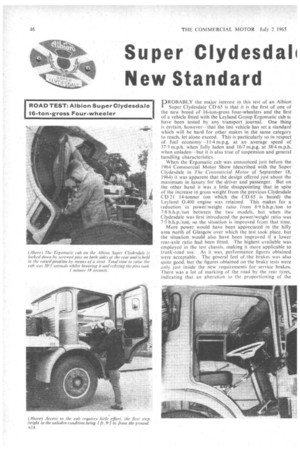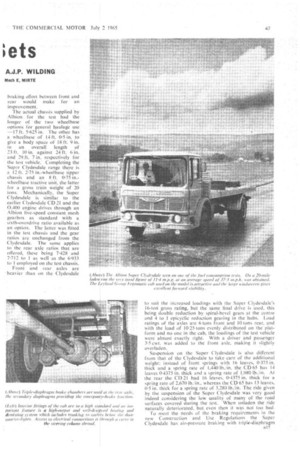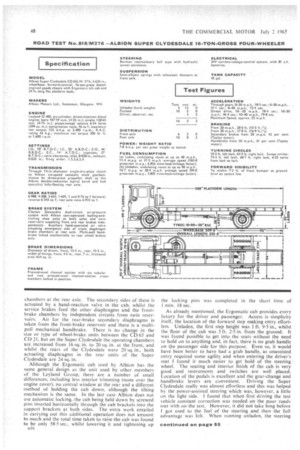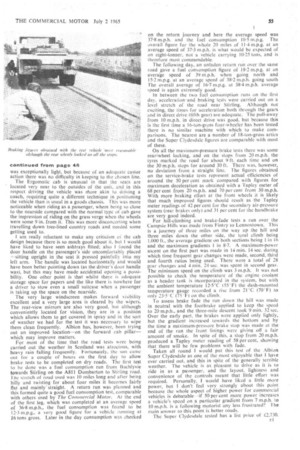Super Clydesdall New Standard e t s
Page 48

Page 49

Page 50

Page 57

If you've noticed an error in this article please click here to report it so we can fix it.
A.J.P. WILDING
Mech E, MIRTE
?PROBABLY the major interest in this test of an Albion 1 Super Clydesdale CD 65 is that it is the first of one of the new breed of 16-ton-gross four-wheelers and the first of a vehicle fitted with the Leyland Group Ergomatic cab lc have been tested by any transport journal. One thing is certain, however—that the test vehicle has set a standard which will be hard for other makes in the same category to reach, let alone exceed. This is particularly so in respect of fuel economy —11.4 m.p.g. at an average speed of 37.3 m.p.h. when fully laden and 16-7 m.p.g. at 38.4 m.p.h. when unladen—but it is also true of suspension and general handling characteristics.
When the Ergomatic cab was announced just before the 1964 Commercial Motor Show (described with the Super Clydesdale in The Commercial Motor of September 18, 1964) it was apparent that the design offered just about the maximum in luxury for the driver and passenger. But on the other hand it wAs a little disappointing that in spite of the increase in gross weight from the previous Clydesdale CD 21 14-tonner ton which the CD 65 is based) the Leyland 0.400 engine was retained. This makes for a reduction in power/weight ratio from 5-9 b.h.p./ton to 7.8 b.h.p./ton between the two models, but when the Clydesdale was first introduced the power/weight ratio was 73 b.h.p./tort, so the situation is improved from that time.
" More power would have been appreciated in the hilly area north of Glasgow over which the test took place, but the situation would also have been improved if a lower rear-axle ratio had been fitted. The highest available was employed in the test chassis, making it more applicable to trunk-road use. As it was, performance figures obtained were acceptable. The general feel of-the brakes was also quite good. but the figures obtained on the brake tests were only just inside the new requirements for service brakes. There was a-lot of marking of the road by. the rear tyres, indicating that an alteration to the proportioning of the
braking effort between front and rear would make for an improvement.
The actual chassis supplied by Albion, for the test had the longer of • the two Wheelbase options for general haulage use —17.ft. 5.625 in. The other has a wheelbase of 14 ft: 0-5 in. to ' give a body space of 18 ft. 9 in. in an overall length of 23 ft. 10 in: against 24 ft. 6 in. and 29.ft. 7 in. respectively for the test vehicle. Completing the Super Clydesdale range there is a 12 ft. 2-75 in.-wheelbase tipper• chassis and an 8.ft. 0.75 in.wheelbase tractive unit, the latter for a gross train weight of 20 tons. Mechanically, the Super Clydesdale is similar to the earlier Clydesdale CD 21 and the 0.400 engine drives through an Albion five-speed constant mesh gearbox as standard with a sixth-overdrive ratio available as an option. The latter was fitted in the test chassis and the gear ratios are unchanged from the Clydesdale. The same applies to the rear axle ratios that are offered, these being 7.428 and 7.712 to 1 as well as the 6-933 to I employed on the test chassis.
Front and .rear axles are heavier than on the Clydesdale
to suit the increased loadings with the Super Clydesdale's 16-ton gross rating, but the same .final drive is used, this being double reduction by spiral-bevel gears at the centre and 4 to 1 epicyClic reduction gearing in the hubs. Load ratings of the axles are 6 tons front and 10 tons. rear, and with the load of 10-25 tons evenly distributed on the' platform and no one in the cab, the loadings of the test vehicle were almost exactly right. With a driver and passenger 3.5 cwt. was added to the front axle, Making it slightly overladen.
Suspension on the Super • Clydesdale is also different from that of the Clydesdale to take care of the additional weight: instead of front 'springs with 16 leaves, 0.375 in. thick and a spring rate of 1,440 Ih./in. the CD 65 has 14
leaves 0-4375 in. thick and a spring rate of 1,980 At the rear the CI) 21 had 16 leaves, 0-4375 in. thick for a spring rate of 2,6701b...!in., whereas the CD 65 has 13 leaves, 0-5 in. thick for a spring rate of 3,280 lb.in. The ride given by the suspension of • the Super Clydesdale was Very good indeed considering the low quality of many of the road surfaces covered during the' test. When unladen the ride naturally deteriorated, but even then it was not too bad. To meet the needs of the braking requirements in the new Construction and Use Regulations the • Super Clydesdale has air-pressure braking with trip!.e-diaphra.gtri chambers at the rear axle. The secondary sides of these is actuated by a hand-reaction valve in the cab, whilst the service brakes feed the other diaphragms and the frontbrake chambers by independent circuits from twin reservoirs. Air for the rear-brake secondary diaphragms is taken from the front-brake reservoir and there is a multipull mechanical handbrake. There is no change in the size or type of wheel-brake units between the CD 65 and CD 21. but on the Super Clydesdale the operating chambers are increased from 16 sq. in. to 20 sq. in. at the front, and whilst the rears of the Clydesdale were 20 sq. in., both actuating diaphragms in the rear units of the Super Clydesdale are 24 sq. in.
Although the Ergomatic cab used by Albion has the same general design as the unit used by other members of the Leyland Group, there are a number of small differences, including less interior trimming (none over the engine cover), no central window at the rear and a different method of holding the cab down, although the tilting mechanism is the same. In the last case Albion does not use automatic locking, the cab being held down by screwed pins inserted horizontally through the cab brackets into the support brackets at both sides. The extra work entailed in carrying out this additional operation does not amount to much and the total time taken to raise the cab was found to be only 58.5 sec., whilst lowering it and tightening up aI6 the locking pins was completed in the short time of 1 min. 18 sec.
As already mentioned, the Ergomatic cab provides every luxury for the driver and passenger. Access is simplicity itself, the location of the forward step making entry effortless. Unladen, the first step height was 1 ft. 9-5 in., whilst the floor of the cab was 3 ft. 2-5 in. from the ground. It was found possible to get into the seats without the need to hold on to anything and, in fact, there is no grab handle on khe passenger side for this purpose. Even so, it would have been better to have had a grab handle, as unassisted entry required some agility and when entering the driver's seat I found it much easier to get hold of the steering wheel. The seating and interior finish of the cab is very good and instruments and switches are well placed. Location of the pedals is excellent and the gear-change and handbrake levers are convenient. Driving the Super Clydesdale really was almost effortless and this was helped by the power-assisted steering which was, however, a little on the light side. I found that when first driving the test vehicle constant correction was needed on the poor roads met with on the test. However, it did not take long before got used to the feel of the steering and then the full advantage was felt. When running unladen. the steering was exceptionally light, but because of an adequate castor action there was no difficulty in keeping to the chosen line. The Ergomatic cab is unusual in that the seats are located very near to the outsides of the unit, and in this respect driving the vehicle was rhore akin to driving a coach, requiring quite a different technique in positioning the vehicle than is usual in a goods chassis. This was more noticeable when riding as a passenger, where being so close to the nearside compared with the normal type of cab gave the impression of riding on the grass verge when the wheels were some 9 in. from it. This was more disconcerting when travelling down tree-lined country roads and needed some getting used to.
I am really reluctant to make any criticism of the cab design because there is so much good about it, but 1 would have liked to have seen ashtrays fitted; also 1 found the door handle on the passenger's side uncomfortably placed =sitting upright in the seat it pressed painfully into my left arm. The handle was located horizontally and would have been better pointing down (as the driver's door handle was), but this may have made accidental opening a possibility. One other point is that whilst there is adequate storage space for papers and the like there is nowhere for a driver to stow even a small suitcase when a passenger is taking up the space on the nearside.
The very large windscreen makes forward visibility excellent and a very large area is cleared by the wipers. The rear-view mirrors are also very good, but although conveniently located for vision, they are in a position which allows them to get covered in spray and in the sort of weather we had for the test it was necessary to wipe them clean frequently. Albion has, however, been trying out an improved location—on the forward cab pillar— which may improve matters.
For most of the time that the road tests were being carried out the weather in Scotland was atrocious, with heavy rain falling frequently. Fortunately, the sun came out for a couple of hours on the first day to allow brake tests to be completed on dry roads. The first test to be done was a fuel consumption run from Iltichlyvie towards Stirling on the A811 Dumbarton to Stirling road. 1 he stretch of road used was 10 miles long and after being hilly and twisting for about four miles it becomes fairly flat and mainly straight. A return run was planned and this formed quite a good fuel consumption test, comparable with others used by The Commercial Motor. At the end of the first leg, which was completed at an average speed of 36.8 m.p.h., the fuel consumption was found to be 11-3 m.p.g.. a very good figure for a vehicle running at 16 tons gross. Later in the day consumption was checked
on the return journey and here the average speed was 37-8 m.p.h. and the fuel consumption 10.5 m.p.g. The overall figure for the whole 20 miles of 11.4 m.p.g. at an average speed of 37-3 m.p.h is what would be expected of an eight-tonner, not a vehicle carrying 10.25 tons, and is therefore most commendable.
The following day, an unladen return run over the same road gave a fuel consumption figure of 18.2 m.p.g. at an average speed of 39 m.p.h. when going north and 15-2 m.p.g. at an average speed of 38.2 m.p.h. going south The overall average of 16.7 m.pl. at 38-4 m.p.h. average speed is again extremely good.
In between the two fuel consumption runs on the first day, acceleration and braking tests were carried out on a level stretch of the road near Stirling. Although not exciting, the times for acceleration both through the gears and in direct drive (fifth gear) are,adequate. The pull-away from 10 m.p.h. in direct drive was good, but because this is the first time a 16-ton-gross four-wheeler has been tested there is no similar machine with which to make comparisons. The nearest are a number of 18-ton-gross artics and the Super Clydesdale figures are comparable with most of these.
On all the maximum-pressure brake tests there was some rear:wheel locking, and on the slops from 20 m.p.h. the tyres marked the road for about 9 ft. each time and on the 30 m.p.h. stops tor around 30 ft. There was, however, no deviation from a straight line. The figures obtained on the service-brake tests represent actual efficiencies of around the 50 per cent mark compared with figures for maximum deceleration as obtained with a Tapley meter of 68 per cent from 20 m.p.h. and 70 per cent from 30 m.p.h. With more braking effort at the front wheels it is likely that muCh improved figures should result as the Tapley meter readings of 42 per cent for the secondary air-pressure system (rear brakes only) and 31 per cent for the handbrake are very good indeed.
For hill-climbing and brake-fade tests a run over the Campsie Hills was made from Fintry to Lennoxtown. This is a journey of three miles on the way up the hill and three miles down the other side, the total climb being 1_000 ft., the average gradient on both sections being 1 in 16 and the maximum gradients I in 8.7. A maximum-power ascent on the first part was made in 14 min. 14 sec. during which time frequent gear changes were made, second, third and fourth ratios being used. There were a total of 28 gear changes and 4 min. 24sec. was spent in second gear_ The minimum speed on the climb was 3 m.p.h. It was not possible to check the temperature of the engine coolant as a header tank is incorporated in the system, but with the ambient temperature 12-5°C (55'F) the dash-mounted temperature gauge recorded a rise from 21°C (70°F) to only 23.5' C (75°F) on the climb.
To assess brake fade the run down the hill was made in neutral with the footbrake applied to keep the speed to 20 m.p.h., and the three-mile descent took 9 min. 32 sec. Over the early part, the brakes were applied only lightly, but the gradient increased towards the bottom and by the time a maximum-pressure brake stop was made at the end of the run the front linings were giving .off a fair amount of smoke. In spite of this, a stop from 20 m.p.h. produced a Tapley meter reading of 58 per cent, showing that there will be few problems with fade.
Taken all round I would put this test of the Albion Super Clydesdale as one of the most enjoyable that I have ever carried out, and this in spite of the generally terrible weather. The vehicle is as pleasant to drive as it is to ride in as a passenger, and the layout, lightness and convenience of the controls meant that little effort was required. Personally. I would have liked a little more power, but I don't feel very strongly about this point because the whole aspect of higher power for commercial vehicles is debatable---if 50 per cent more power increases a vehicle's speed On a particular gradient from 7 m.p.h. to 10 m.p.h. is a following motorist any less frustrated'? 1-he main answer to this point is better roads.
The Super Clydesdale tested has a list price of i:2,730. ni
























































































































